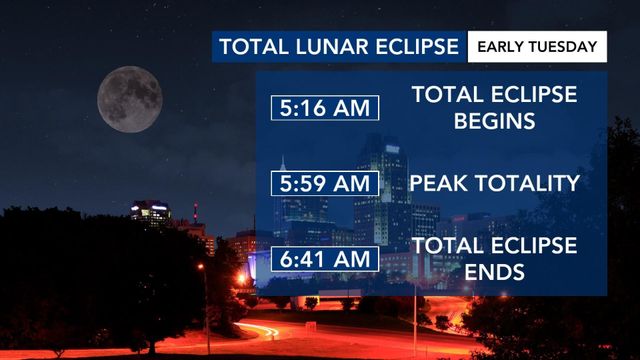Get up early to see total lunar eclipse before you vote on Election Day
The Sun, Earth, and Moon (in that order) will put on a show before dawn on Election Day 2022 with a total lunar eclipse visible across the country. The East Coast will see the eclipse, weather permitting of course, from the beginning of the partial phase through to the end of the partial phase around moonset.

Tuesday, November 8, 2022
- Penumbral eclipse begins 3:02 a.m. The Moon enters the penumbra, the lighter portion of the Earth's shadow. This isn't as noticeable.
- Partial eclipse begins 4:09 a.m. A dark circle moves across the face of the Moon as it enters the umbra, the darker portion of the Earth's shadow.
- Total eclipse begins 5:16 a.m. The Moon completely enters the umbra and quickly takes on a deep orange color.
- Maximum eclipse at 5:59 a.m. The Moon is at its closest to the center of the umbra shadow and takes on its deepest orange/red color
- Polls open: 6:30 a.m.
- Total eclipse ends 6:41 a.m. The Moon reaches the edge of the umbra shadow; the orange color will fade to a dark gray as the Moon moves into the brighter penumbral shadow.
- Moonset 6:49 a.m.
- Partial eclipse ends 7:49 a.m. (below the horizon)
- Penumbral ends 8:56 a.m. (below the horizon)
![Tony Rice: How to watch Tuesday's total lunar eclipse Tony Rice: How to watch Tuesday's total lunar eclipse]()
Tony Rice: How to watch Tuesday's total lunar eclipse
Getting up a little early to see the eclipse on Tuesday should be just a little less painful. We gain an hour of early morning daylight on Sunday as daylight saving time ends.

This is also the first total lunar eclipse to fall on Election Day as we know it. This won't happen again until 2394, and only voters in American Samoa, Hawaii, and Alaska will see that eclipse. The east coast will have to wait until November 2, 2590, for the next Election Day eclipse.
But it's not the first time there has been a total lunar eclipse visible on a day when Americans cast their ballots.
Congress didn't settle on the first Tuesday after the first Monday in November as Election Day until 1845 with the Presidential Election Day Act. Before then, states held their elections any time they pleased within a 34-day period before the first Wednesday in December, according Evan Andrews at the History Channel,
The last Election Day total lunar eclipse was Nov. 3, 1808, a Thursday, when James Madison was on his way to being elected the fourth president.
There was another more recent total lunar eclipse 1844, which fell during the month-long voting period. But Nov. 24, 1844, was a Sunday so polls were closed.
The lunar eclipse of Nov. 3, 1846, probably shouldn't count either since it was a penumbral eclipse – an eclipse which is not as noticeable and does not display the orange or red color.
A complete list of the lunar eclipses on Election Day(s) from the first presidential election in 1788 through the year 3000, along with source code used to calculate this bit of astronomical/election trivia, is available in this GitHub repository.
The next eclipse will be an annular solar eclipse on April 20, 2023, where we'll see about 1/3 of the Sun blocked by the Moon.












